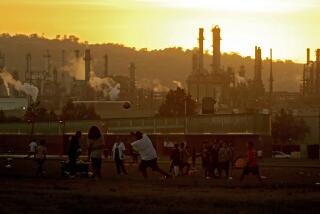THE TIMES 100 : THE BEST PERFORMING COMPANIES IN CALIFORNIA : VIEW FROM THE STREET : Perils of Payouts : Low-Yield Stocks Often Out-Perform Big-Dividend Issues
- Share via
The peril of investing in stocks solely because they pay high dividends is amply illustrated by changes on The Times’ list of 15 California companies with the highest dividend yields--annual dividends as a percentage of price per share.
High dividends may look appealing to income-oriented investors. But anyone who blindly selected some of last year’s high-dividend stocks without looking at financial fundamentals would have been courting disaster. Some firms continued to pay high dividends--in one case, payouts were higher than annual earnings per share--even as stock prices plummeted. The result was unusually high dividend yields.
That was clearly the case with Pacific Gas & Electric, which last year topped The Times’ list with a double-digit cash dividend yield of 12.19%.
PG&E;’s lofty ranking stemmed mainly from a drop in its stock price that was precipitated by concern that the company would cut its dividend, which at the time was $1.93 a share. PG&E;, which owns the Diablo Canyon nuclear power plant, eventually did cut its dividend 27% in October, 1988, after agreeing to a rate settlement for the plant that resulted in a $1.43-per-share writeoff for disallowed project costs.
PG&E;’s stock has since risen more than $2 above last year’s level. That, combined with the dividend cut, knocked PG&E; to No. 5 on The Times’ list of companies with the highest dividend yields.
High dividend rates for some financial institutions on this year’s list reflect their own travails.
Mercury Savings & Loan Assn., for example, made The Times’ list not just because its dividend is high but because its stock price is depressed. The savings and loan--which resumed paying quarterly cash dividends in September, 1985, after a six-year hiatus--saw its stock price plummet to $5.50 in early April from more than $12 at the end of 1987 after it was disclosed that federal regulators planned to order Mercury to record a $7.4-million loss instead of the institution’s previously announced $6.1-million profit for 1988.
“You always have to look at the earnings growth, cash flow and whether a company has lower debt service or capital spending requirements; you can’t just pick a stock by high yields alone,” said Sarah A. Stack, associate director of research for the Los Angeles brokerage Bateman Eichler, Hill Richards.
Indeed, while the dividends may appeal to those seeking income, several studies have shown that stocks with high yields are often outperformed by stocks with low yields, even after dividends are reinvested. Experts point out that part of the reason for the generally better performance of stocks with low yields is that companies that pay high yields are often mature enterprises that have reached a plateau in their growth.
Analysts say investors shouldn’t rush to buy high-yield stocks until they’ve thoroughly analyzed a company’s underlying financial performance. Investors should also consider historical factors about the dividend itself, experts say, including how long a company has been paying dividends, whether it has missed any dividend payments and whether dividend payouts have risen over time.
What’s more, stocks with yields greater than short-term Treasury bill rates--which have soared to more than 9% recently--are likely to carry more risk or question marks.
Even so, high-dividend stocks are suitable for some investors--retirees and others who need constant dividend income and are wary of stock market volatility. Utility stocks, which dominate The Times’ list this year, are often favorites of such investors.
(The dividend list excludes master limited partnerships and real estate investment trusts because their dividends often include a return of investors’ capital.)
Some experts see a trend away from dividends, in part because of their tax disadvantages. Shareholders in companies that pay dividends suffer from double taxation--first when the company they own is taxed on the income it earns, then again when dividends become subject to personal income tax.
“The real mystery for academics is why companies pay dividends at all,” said Lawrence E. Harris, an associate professor of finance and business economics at the University of Southern California. “Firms that want to distribute cash can either issue a dividend or they can use the cash to go into the market and buy their own shares--thereby distributing cash without imposing taxes on shareholders.”
DIVVYING IT UP
Companies ranked by dividend as a percentage of stock price.
Cash dividend 4/3/89 Rank Company as % of yield stock price 1 Occidental Petroleum Corp. 9.26 27.00 2 Pacific Enterprises 8.81 39.50 3 PLM International Inc. 8.11 9.38 4 Southern California Water Co. 8.00 25.25 5 Pacific Gas & Electric 7.83 17.88 6 SCEcorp 7.81 31.75 7 Mercury Savings & Loan 7.27 5.50 8 San Diego Gas & Electric 7.13 37.88 9 California Water Service Co. 7.07 23.75 10 SJW Corp. 6.62 27.50 11 Dominguez Water Corp. 6.46 14.25 12 CalFed Inc. 6.26 22.38 13 Homestead Financial Corp. 6.25 4.00 14 First Interstate Bancorp 6.10 47.88 15 Glenfed Inc. 6.08 19.75
*See exceptions, page 38.
**See company notes, page 29.
More to Read
Inside the business of entertainment
The Wide Shot brings you news, analysis and insights on everything from streaming wars to production — and what it all means for the future.
You may occasionally receive promotional content from the Los Angeles Times.










